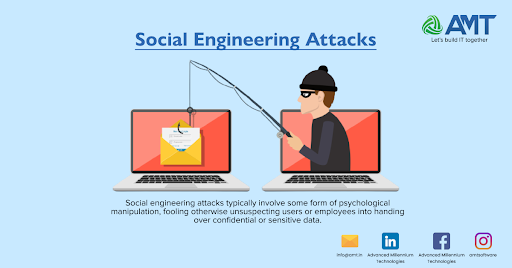Social engineering attacks are a category of cyberattacks that rely on manipulating individuals into revealing confidential information, providing access to computer systems, or taking actions that compromise security. These attacks exploit human psychology and emotions rather than technical vulnerabilities. There are several common types of social engineering attacks, including:
- Phishing: In a phishing attack, an attacker sends deceptive emails, messages, or websites that appear to be from a trusted source, such as a bank or a reputable organization. The goal is to trick the recipient into revealing personal information, login credentials, or financial details.
- Pretexting: Pretexting involves the attacker creating a fabricated scenario to obtain information from a victim. This might involve posing as an authority figure or someone in need of help and using that guise to extract sensitive information.
- Baiting: Baiting attacks use enticing offers or promises to lure victims into downloading malicious software or sharing their credentials. Often, attackers offer free downloads, such as movies or software, to entice victims.
- Tailgating: In a tailgating attack, an attacker gains unauthorized physical access to a restricted area by following an authorized person through a secure entry point, relying on their trust or politeness.
- Quid Pro Quo: This tactic involves an attacker offering a service, such as IT support or assistance, in exchange for information or access. Once the victim provides what the attacker wants, they may exploit it for malicious purposes.
- Impersonation: Attackers may impersonate someone in a position of authority, such as a company executive, a government official, or a coworker, to deceive a victim into taking specific actions.
- Vishing (Voice Phishing): Vishing is a form of phishing carried out over the phone. Attackers call individuals and impersonate trusted entities, trying to extract personal or financial information.
- Reverse Social Engineering: In this type of attack, the victim is manipulated into approaching the attacker, who then exploits the victim’s trust to gain access or information.
- Watering Hole Attack: Attackers compromise websites frequently visited by their target victims and inject malicious code. When the victims visit the site, they unknowingly download malware.
- Psychological Manipulation: Some social engineering attacks rely on emotional manipulation and psychological tactics to persuade victims to act against their own best interests. For example, they may exploit fear, urgency, or trust to deceive individuals.
Countermeasures against social engineering attacks include employee training, security awareness programs, robust access control, email filtering, two-factor authentication, and vigilance in verifying the identity of people requesting sensitive information or access. It’s important to stay informed about the latest social engineering tactics and be cautious when dealing with unsolicited requests for personal or sensitive information, whether online or in person.
Certainly, here are some additional details on social engineering attacks and ways to protect against them:
- Pharming: Pharming attacks involve redirecting users to fraudulent websites by manipulating the DNS (Domain Name System) or compromising the user’s local hosts file. Users may think they are visiting a legitimate site, but their information is being collected by attackers.
- Malware Distribution: Social engineering can be used to trick users into downloading and executing malware. For example, an attacker might send an email with a seemingly harmless attachment or a link to a malicious website that infects the victim’s computer.
- Human-Based Impersonation: Attackers may physically impersonate someone to gain access to restricted areas. This could involve dressing as a repair technician, delivery person, or janitor to avoid suspicion.
- Online Social Engineering: Beyond email, social engineering can occur through various online platforms, including social media, messaging apps, and dating websites. Attackers create convincing profiles to manipulate victims.
- Spear Phishing: Spear phishing is a targeted form of phishing where attackers customize their messages for specific individuals or organizations. They often use personal information or details to make their messages more convincing.
- Hunting for Personal Information: Attackers often gather personal information about their targets from social media, public records, or online sources to make their social engineering attempts more convincing. Protecting your personal information and being cautious about what you share online is essential.
Ways to Protect Against Social Engineering Attacks:
- Education and Training: Regularly train employees and individuals to recognize common social engineering tactics and how to respond to them. Encourage skepticism and the verification of requests for sensitive information.
- Use Multi-Factor Authentication (MFA): MFA adds an extra layer of security by requiring multiple forms of verification to access an account, making it more challenging for attackers to gain unauthorized access.
- Implement Strong Password Policies: Encourage the use of complex, unique passwords and regularly change them. Password management tools can help users create and manage strong passwords.
- Secure Your Online Presence: Be cautious about the information you share on social media and other online platforms. Avoid disclosing personal details that can be used against you in a social engineering attack.
- Verify Requests: Always verify any unusual or unexpected requests for information, access, or financial transactions, especially if they come through email or phone calls.
- Use Email Filtering: Implement email filtering and security software to identify and block phishing attempts and malicious attachments.
- Keep Software and Systems Updated: Regularly update your operating system, applications, and antivirus software to patch known vulnerabilities.
- Access Control: Limit access to sensitive areas and information. Not everyone needs access to all data or areas within an organization.
- Physical Security: Maintain strict physical security measures to prevent unauthorized personnel from entering secure areas.
- Incident Response Plan: Develop an incident response plan to address and mitigate the impact of successful social engineering attacks.
Remember that social engineering attacks can take on many forms and constantly evolve. Staying informed, remaining vigilant, and using a combination of technology and human awareness are key to mitigating these threats.
Above is a brief about Social Engineering Attacks. Watch this space for more update on the latest trends in Technology.
